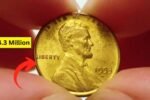The Lincoln Wheat Penny, a small coin with a big history, is making waves among collectors and everyday Americans alike. Some rare versions of this penny, first minted in 1909, are reportedly worth up to $2.5 million. Amazingly, these valuable coins might still be out there, mixed in with loose change. With rising interest in coin collecting, people are checking their pockets and piggy banks for these hidden treasures. But which pennies are worth a fortune Above ground
Why Are Some Lincoln Pennies So Valuable?
The Lincoln Wheat Penny, featuring Abraham Lincoln’s face on one side and wheat stalks on the back, was minted from 1909 to 1958. Certain years and mint marks make some pennies incredibly rare. For example, the 1909-S VDB penny, with only 484,000 made, is a collector’s dream. Its value comes from low production, historical significance, and the tiny “VDB” initials of designer Victor David Brenner. Other rare ones, like the 1943 bronze penny, were mistakes—most 1943 pennies were made of steel due to wartime copper shortages. If these rare coins are in great condition, they can fetch millions at auctions.
Are These Pennies Still Out There?
Believe it or not, some of these valuable pennies might still be in circulation. People often overlook old coins, and many end up in cash registers, vending machines, or jars at home. Coin experts say it’s rare but possible to find a 1909-S VDB or 1943 bronze penny in everyday change. In 2019, a man in Massachusetts found a 1943 bronze penny worth over $200,000 in his pocket change. Stories like this fuel excitement, but you’d need sharp eyes and a bit of luck to spot one. Checking your coins could be worth it!
How to Spot a Million-Dollar Penny
Identifying a valuable Lincoln Wheat Penny takes a little know-how. Look at the year and mint mark, a small letter under the date (“S” for San Francisco, “D” for Denver, or no letter for Philadelphia). Key dates to watch for include 1909-S VDB, 1914-D, 1922 No D, and 1943 bronze. Check the coin’s condition—ones with clear details and no heavy wear are worth more. A magnifying glass can help you spot the “VDB” on the back of 1909-S pennies. If you think you’ve got a rare one, take it to a professional coin dealer for appraisal.
| Penny Type | Key Features | Estimated Value |
|---|---|---|
| 1909-S VDB | “S” mint mark, “VDB” on back | Up to $2.5 million |
| 1943 Bronze | Bronze, not steel; no mint mark common | Up to $1 million |
| 1914-D | “D” mint mark | Up to $250,000 |
| 1922 No D | No mint mark, weak strike | Up to $100,000 |
Why Collectors Are Crazy About Them
The high value of these pennies comes from their rarity and history. Collectors love coins tied to unique moments, like the 1943 bronze error during World War II. Auction records show a 1909-S VDB penny sold for $2.5 million in 2023, and a 1943 bronze penny hit $1 million in 2021. The thrill of finding one keeps collectors and hobbyists searching. Plus, with inflation making every dollar count, the idea of a single penny paying off a house is hard to resist.
What Should You Do Next?
Start checking your change! Look at every Lincoln Wheat Penny you come across, especially pre-1958 ones. Use a magnifying glass to inspect the date, mint mark, and condition. If you find a suspicious coin, don’t clean it cleaning can lower its value. Visit a local coin shop or contact a grading service like PCGS or NGC for an expert opinion. For updates on rare coins, check trusted sites like pcgs.com or ngccoin.com. Who knows? That penny in your pocket could be your ticket to millions.



